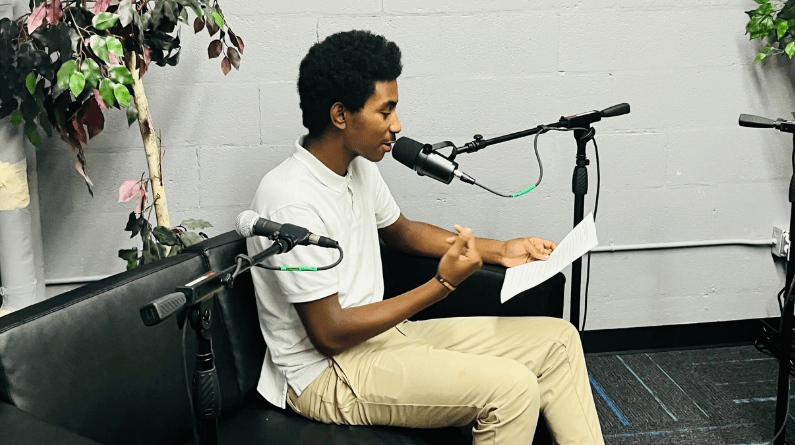Live Performance and Recording Station

Recording Station
Microphones
Microphones pick up audio for amplification and recording. There are multiple types of microphones, each with their own features. Choosing the right microphone for recording will depend on your space, instrument, and taste.
The two most common types of microphones are Dynamic and Condenser microphones. Dynamic mics are less sensitive and more directional, and work well in an untreated or live environment. These microphones are commonly used for live performances or to record loud instruments. Condenser mics are more sensitive and work well for detailed recording in a quiet environment. These are commonly used to record vocals, acoustic instruments, and ambient sounds. Condenser microphones require the use of Phantom Power, which often is a button or switch on an interface or mixing board labeled “48V” or “Phantom.”
Audio Interfaces
Audio interfaces are essentially physical boxes that allow you to send and receive audio. They usually have multiple inputs and outputs, acting as a big connector between your digital audio workstation (DAW) and different sound sources. You can use them to receive and record audio from various microphones and instruments, and to send audio to your computer, headphones, and speakers.
Signal Flow
Signal flow is the order of operations a sound goes through for you to hear it. There are multiple steps between the source of a sound and when you hear it through headphones or speakers, and understanding these steps is crucial to troubleshooting issues and for creating high-quality recordings. Whatever happens at one stop along the signal’s pathway will affect wherever the audio goes next.
DI Instruments
Instruments with outputs (typically 1/4 in TS outputs) can be plugged directly into audio interfaces without the use of a microphone, and can also be plugged into audio hardware like compressors, reverb units, EQs, effects pedals, etc. Common DI (direct input) instruments are electric guitars, electric basses, electric pianos, and synthesizers.
Performance Station
PA System and Mixing Board
Similarly to an Audio Interface, PA (public address) systems and Mixing Boards are used to organize audio signals from microphones and DI (direct input) instruments and amplify them through speakers. The main difference is the size.
Microphones
Microphones for live performance have special requirements. They must be sensitive enough to get a clean signal from the vocalist or instrumentalist that is using them, but not so sensitive that they pick up too much signal from adjacent sound sources. The most common microphone for live performance is the Shure SM58. It is a very directional and durable dynamic mic, making it a great choice for many different situations. Most stage mics use an XLR cable to connect to a PA, but there are wireless options available as well.
Amplifiers
Amplifiers (amps) are used for electric instruments to make sound on stage. Electric guitars, basses, keyboards, and more can be plugged into amplifiers for live performances. Amps are also used as a tone-coloring tool and sometimes have multiple parameters that can be adjusted to create the sound that you want. These parameters include drive, bass/treble knobs, and sometimes creative effects like reverb and delay. Oftentimes, amps are mic’d up and that signal is sent to the PA system.
Direct Input Boxes
Direct input boxes, or DI boxes, are used for electric instruments to send signals directly to the PA system. This is an alternative option to an amplifier, and can be used when you don’t desire the tone-coloring effects of an amp. DI boxes are frequently used for acoustic guitars with pickups, keyboards, synthesizers, and for sending pre-recorded tracks from an audio interface.
Breaking Down and “Zeroing Out” the Board
When a live performance is finished, it is important to maintain the equipment in pristine condition by making sure to wrap all cables correctly, store fragile items in proper containers/cases, and to bring all controls and levels of the PA back to where they were before any changes were made. This process is called “zeroing out” the board.
Cable Directory
⭕ Check it out! Cable management and storage
Equipment Resources
Setting up and using an Audio Interface
Checking a microphone and gain-staging for levels
Setting Up and Using a PA System
Using a Mixer
Table of contents
